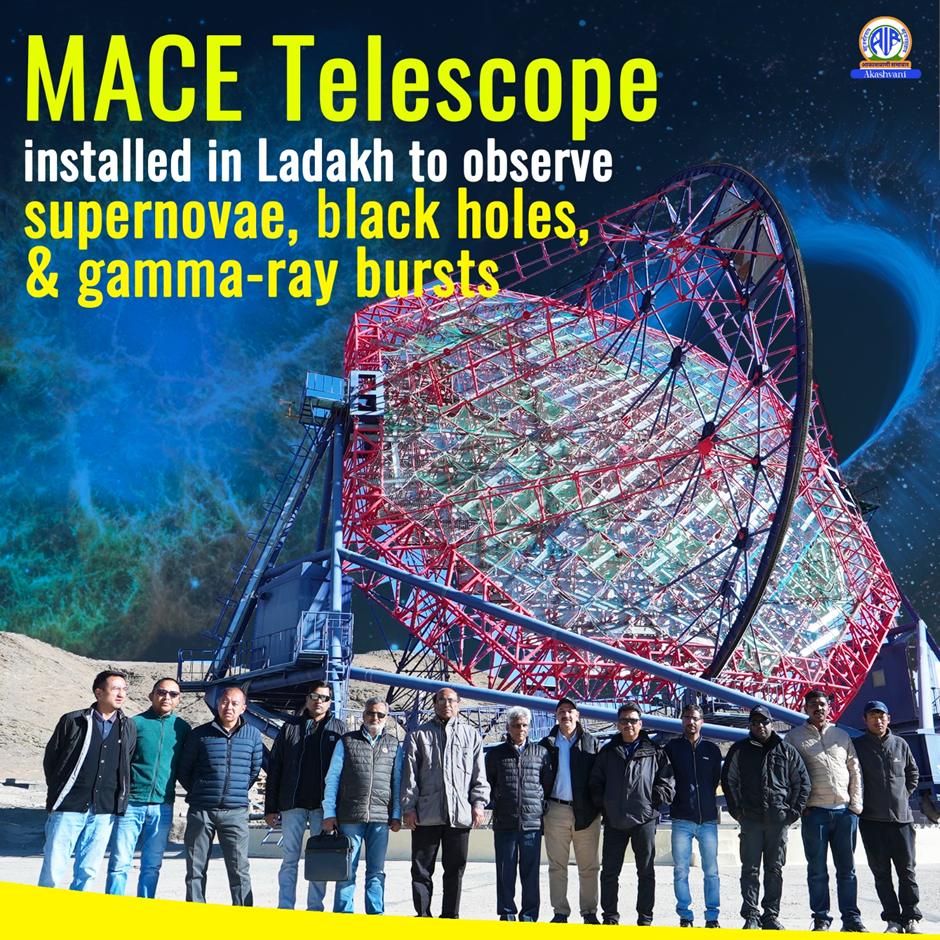- Courses
- GS Full Course 1 Year
- GS Full Course 2 Year
- GS Full Course 3 Year
- GS Full Course Till Selection
- Online Program
- GS Recorded Course
- NCERT (Recorded 500+ Hours)
- Polity Recorded Course
- Geography Recorded Course
- Economy Recorded Course
- AMAC Recorded Course
- Modern India, Post Independence & World History
- Environment Recoded Course
- Governance Recoded Course
- Science & Tech. Recoded Course
- International Relations and Internal Security Recorded Course
- Disaster Management Module Course
- Ethics Recoded Course
- Essay Recoded Course
- Current Affairs Recoded Course
- CSAT
- 5 LAYERED ARJUNA Mentorship
- Public Administration Optional
- ABOUT US
- OUR TOPPERS
- TEST SERIES
- FREE STUDY MATERIAL
- VIDEOS
- CONTACT US
MACE in Ladakh Opens a Unique Eye to Cosmic Gamma Rays
MACE in Ladakh Opens a Unique Eye to Cosmic Gamma Rays
27-11-2024

- On October 4, the Major Atmospheric Cherenkov Experiment (MACE) telescope was inaugurated in Hanle, Ladakh, marking a significant milestone in India’s scientific and technological progress.
- This advanced facility, developed by several Indian research institutions, is set to make groundbreaking contributions to the field of gamma-ray astronomy.
1. What is the MACE Telescope?
- MACE is a ground-based gamma-ray telescope designed to detect and study extremely high-energy gamma rays from cosmic sources.
- Its unique design and location will allow it to observe phenomena that are otherwise difficult to study from the ground.
Key Points:
- Development: Indigenously built by Bhabha Atomic Research Centre (BARC) with support from ECIL and other Indian partners.
- Inauguration Date: October 4, 2024
- Location: Hanle, Ladakh (4.3 km above sea level)
- Size: MACE features a 21-meter-wide dish, making it the largest Cherenkov telescope in Asia.
- Purpose: To study high-energy gamma rays emitted from energetic cosmic objects like black holes, pulsars, and gamma-ray bursts.
2. What Are Gamma Rays and Why Are They Important?
- Gamma rays are the most energetic form of light in the electromagnetic spectrum. They have the shortest wavelength and the highest energy.
- While visible light has energy levels in the range of 1.63-3.26 electron volts (eV), gamma rays carry over 100,000 eV per particle.
- Gamma rays are produced by some of the most energetic and exotic phenomena in the universe:
- Pulsars (rotating neutron stars)
- Supernova explosions
- Black holes and their accretion disks
- Gamma-ray bursts (intense bursts of gamma radiation)
- Despite their high energy, gamma rays are blocked by Earth's atmosphere, which prevents them from reaching the surface.
- To study these rays, scientists use indirect methods from the ground, such as Cherenkov radiation.
3. What is Cherenkov Radiation?
- When a gamma ray enters the Earth's atmosphere, it interacts with air molecules, creating a shower of particles (electron-positron pairs).
- These particles travel faster than the speed of light in air, which causes them to emit a faint blue light called Cherenkov radiation.
- This light is visible in the violet and blue range and is produced almost instantaneously.
- Cherenkov radiation spreads out over a large area, and special instruments, called Imaging Atmospheric Cherenkov Telescopes (IACTs), are used to detect and analyze this light.
- MACE is one of the most advanced IACTs in the world, designed to capture these faint signals and convert them into valuable scientific data.
4. The Technology Behind MACE
- MACE’s light collector consists of 356 mirror panels, each made up of 4 smaller mirrors arranged in a honeycomb structure.
- This design makes the mirrors lighter and more stable, improving their ability to capture and reflect Cherenkov radiation efficiently.

- The mirrors focus the light onto a high-resolution camera, which contains 1,088 photomultiplier tubes.
- These tubes amplify the faint Cherenkov light and convert it into electronic signals for analysis.
Key Features:
- High-Energy Detection: MACE is designed to detect gamma rays with energies over 20 billion eV.
- Moving Telescope: The telescope is mounted on a base with six wheels and can rotate both vertically and horizontally to observe the sky in all directions.
- Altitude Advantage: The high-altitude location of 4.3 km above sea level allows MACE to avoid interference from atmospheric disturbances, ensuring clearer observations.
5. The Search for Dark Matter: MACE’s Role
- One of the most exciting scientific goals of the MACE telescope is to search for evidence of dark matter, which is thought to make up over 85% of the mass of the universe.
- While dark matter has been theorized, scientists do not yet know what particles it is made of.
- A leading candidate for dark matter particles are WIMPs (Weakly Interacting Massive Particles).
- When WIMPs collide and destroy each other, they are believed to release high-energy gamma rays.
- MACE will help detect these gamma rays, particularly from regions like galaxy clusters or the center of galaxies, which might be rich in dark matter.
- MACE will help answer two key questions:
- Are WIMPs real?
- Do WIMPs make up dark matter?
6. Why is MACE Important for India and the World?
- India has been involved in gamma-ray astronomy for over 50 years.
- The launch of MACE represents a major leap forward, with most of its subsystems built and designed in India.
Scientific Impact:
- Understanding High-Energy Astrophysics: MACE will provide valuable insights into some of the most extreme and energetic processes in the universe.
- Advancing Particle Physics: The telescope will also help scientists study particle physics at the highest energy levels, including the search for dark matter and other cosmic mysteries.
Technological Achievements:
- MACE is India’s first such high-energy telescope.
- The project strengthens India’s role in international space and astronomy research.
Looking Ahead: MACE’s Potential for Future Discoveries
- MACE is still in its early stages, but it has already shown the potential to detect high-energy gamma rays that could be linked to dark matter and other fundamental phenomena in the universe.
- In addition to its dark matter research, MACE will help improve our understanding of the most energetic objects in space, including black holes, supernovae, and pulsars.
- As MACE continues to collect data and make discoveries, it could provide critical information that will shape the future of astrophysics and particle physics.
Conclusion
The MACE telescope in Ladakh is an incredible scientific advancement, offering a unique window into the study of high-energy gamma rays from cosmic sources. With its cutting-edge technology and strategic location, MACE will not only help explore the mysteries of the universe but also contribute to India’s growing role in global scientific research. By studying cosmic phenomena such as dark matter and gamma-ray bursts, MACE will provide crucial insights into the fundamental workings of the universe.




